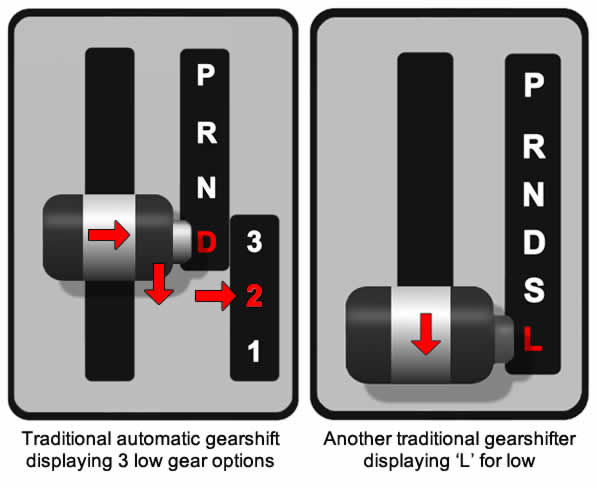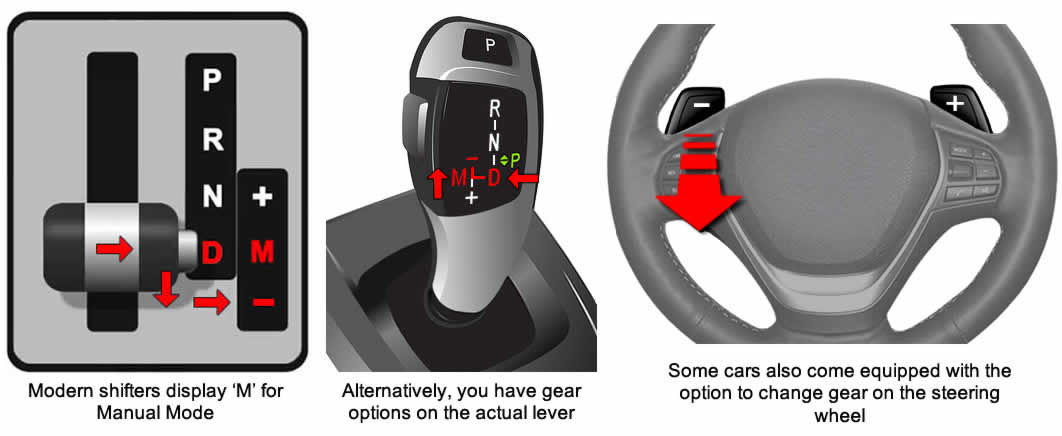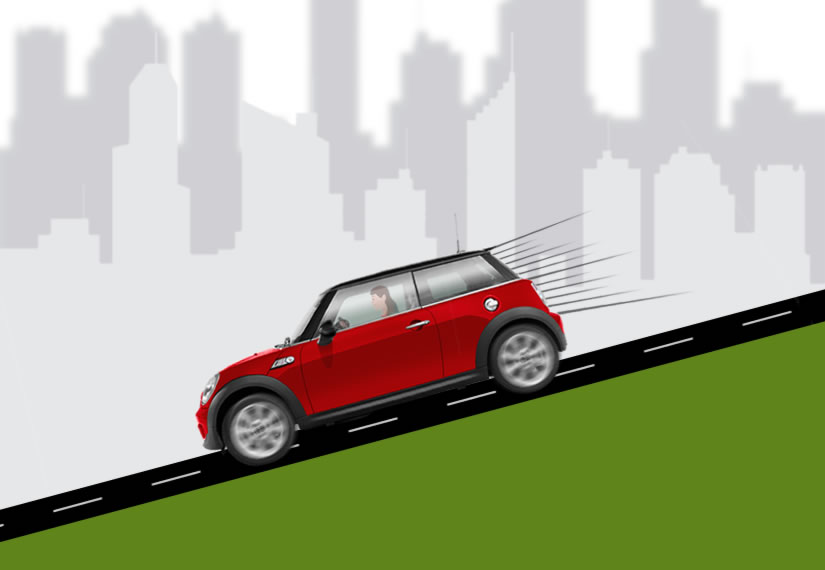When driving downhill in any car, regardless of whether it’s manual or automatic, it requires a combination of using the vehicle’s brakes (footbrake) and engine braking.
Engine braking is a term used to described the resistance produced in the engine when you take your foot off the accelerator pedal. If you change down a gear whilst leaving your foot off the accelerator, you’ll notice that the car slows down to a greater extent. A vacuum inside the engine along with the friction of the engine’s components creates this resistance and that’s what’s referred to as engine braking.
If we use only the footbrake for slowing the vehicle downhill, we risk overheating the vehicle’s brakes which can result in brake fade. Brake fade occurs due to the brake pads and discs overheating and/or the brake fluid boiling. The brake pedal may feel firm to press, but the brakes become unresponsive, or if the brake fluid boils, the pedal become spongy.
To help reduce the load on the vehicle’s brakes and to therefore reduce the possibility of overheating, we combine the use of the footbrake along with engine braking.
How to Drive Downhill in an Automatic Car
Use this technique for driving downhill in an automatic car:
1. Slow Your Vehicle Down
Before starting off downhill, prepare the vehicle for an appropriate speed for changing down gears to avoid damaging the transmission. Use the footbrake to slow down.
2. Change to a Lower Gear
Now that you’ve slowed down, change from Drive (D) to a lower gear. Not all automatic gear shifters are the same, so you’ll need to look at yours to see what low gear options you have.

If your vehicle has a traditional automatic gear shifters, you may have the option of 2 or 3 low gears. From Drive (D), select 2nd gear or if the downhill slope is really steep and you want to keep your vehicle very slow, shift into 1st gear. Just ensure you first slow down enough before shifting into 1st gear. Alternatively, you may see ‘L’, for low gear. This will keep your gears locked into a lower gear, ideal for travelling downhill.

On modern automatics, you’ll often see the letter ‘M’ along with a plus (+) and minus (-) symbol. The ‘M’ stands for manual mode and when in this mode, you can manually shift up and down gears. Simply pull the gear lever to the right into manual mode and pull the lever down down down shift one gear. You will see what current gear you’re in on your car’s dashboard. Keep pulling the lever down to the minus (-) symbol until you reach 2nd gear.
With some automatics, you need to operate the lever itself, much like a joystick. Operate the gear lever into manual mode and follow the directions on the lever to lower the gears.
Some automatics will also have the option to change gear using paddle shifters at the steering wheel. The principle is the same, pull the paddle that has the minus (-) symbol on it, (usually the left paddle) until you reach 2nd gear.
If your vehicle has an ‘Overdrive Off’ button, press it to switch it off. Overdrive is on by default and it keeps the car in the highest available gear, keeping the engine speed as slow as possible to reduce fuel consumption.
3. Cover the Brake
Cover the brake simply means to hold your foot over the brake pedal in preparation to use it. On a steeper downhill gradient, it’s unlikely you’ll be able to rely on engine braking alone, so be prepared with the footbrake.
4. Use the Footbrake to Maintain a Steady Speed
As you begin to descend the hill, you’ll need to maintain a steady speed. Due to gravity, you’ll likely gain speed, so use progressive braking to gently apply brake pressure, gently increasing pressure until you reach your desired speed, then release the pedal.
Avoid riding the brakes, in other words, try to avoid keeping pressure on the brakes constantly as this will increase heat within the vehicle’s brake system. It’s best to use short bursts of braking, slowing right down, then coming off the brake pedal to allow cooling.
For example, if you’re traveling downhill at 20 mph, use the brakes to slow down to 15 mph, then release the brake pedal. Keep repeating this process. If you’re gaining too much speed, use the footbrake to slow right down and shift to an even lower gear. Traveling downhill at a slower speed will reduce the heat build-up in your brakes.
Things to Avoid When Driving Downhill
When attempting to drive downhill in an automatic car, ensure to avoid making these mistakes:
Avoid Keeping the Transmission in Drive
Avoid keeping your car’s transmission in Drive (D). In Drive, your vehicle’s transmission is designed to be fuel efficient, meaning that it’ll shift to to higher gears. Higher gears will not provide you with engine braking, so always shift into a low gear.
Avoid Keeping the Transmission in Neutral
Additionally, avoid placing your transmission into Neutral (N). Neutral means there are no gears assigned, so you’re essentially free wheeling, or ‘coasting’. Again, this will provide zero benefit in terms of engine braking.

Thank you
Very valuable information
Very enlightening, thank you.
On long downhill runs – get into a low enough gear to avoid using the brake. The brake can only absorb and dissipate a small amount of energy compared to the energy that running the car downhill releases. You should be applying the throttle (gas pedal) occasionally to speed up on flatter sections and the car should slow slightly when both feet are off the pedals on the normal grade.
The engine braking works by using the kinetic energy of the moving vehicle to compress the air inside the cylinders which heats the air, the energy is then released as hot air out the exhaust pipe. That energy does not get to the brakes – leaving them cool enough to still work in an emergency if needed.
As long downhills usually involve tight turns it’s extremely dangerous when the brakes don’t work. If you find you are needing to brake often, then slow down and go down a gear BEFORE the brakes overheat. If even the lowest gear is ineffective stop every few minutes, apply the park brake and wait 5 minutes for the brakes to cool. If you often drive on long steep descents a manual gearbox and (especially with a diesel engine) is better suited.